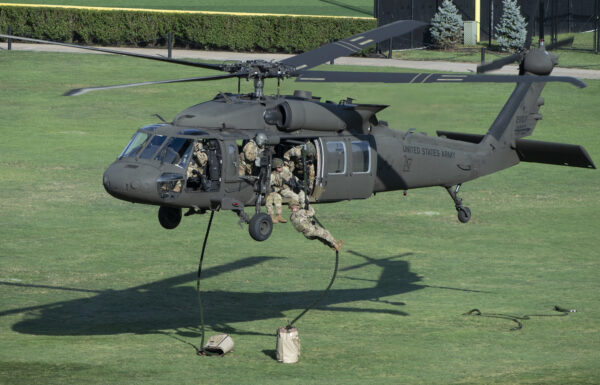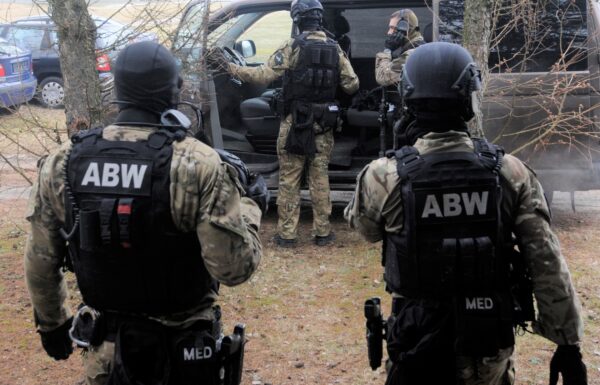AMSTA
During the second day of the Kielce trade fair, the WB Group presented a project for integrating previously developed products into a single, global system. The concept of A4S FORCULUS involves coupling sensors, communications at various levels, and software that enables resource management in the event of a crisis. The entire system is to be supported by elements of artificial intelligence, developed by the Polish company.
 Police vehicle carrying the integrated communication server of the WB Group’s system / Photos: Jakub Link-Lenczowski
Police vehicle carrying the integrated communication server of the WB Group’s system / Photos: Jakub Link-Lenczowski
The first of the components to be integrated is the AMSTA perimeter protection system developed by MINDMADE, a company within the WB Group. This is a digital border and critical infrastructure protection system based on a network of various types of seismic and imaging sensors, enabling centralized management and local access for patrols and response teams.
This is one of the more advanced solutions of its type. The manufacturer emphasizes a high degree of reliability and resistance to interference, tested under field conditions. Moreover, learning algorithms utilized allow for the filtering of environmental signals, thereby relieving the operator by eliminating most false signals. AMSTA is available in both a wired version (components are connected by a fiber optic network and connected to a permanent power source) and a wireless version. Thanks to its open and scalable architecture, it can work with various types of sensors and management software.
 Seismic sensors detection range for various kinds of signals. It is worth noting that AMSTA can detect flying vehicles (even planes on cruising altitudes). It can be used to detect unmanned aerial vehicles flying below the detection range of radars
Seismic sensors detection range for various kinds of signals. It is worth noting that AMSTA can detect flying vehicles (even planes on cruising altitudes). It can be used to detect unmanned aerial vehicles flying below the detection range of radars
AMSTA is designed for uniformed services to protect military facilities, border security, and critical national infrastructure objects (airports, large industrial plants, drinking water intakes, power plants, fuel depots, refineries, etc.) (AMSTA will protect the borders).
PIK-MC
The next solution that can be integrated is the Mission Critical Communication Integration Platform (Platforma Integracji Komunikacji Mission Critical, PIK-MC). PIK is a mobile system for dispatcher communication of long range, data transmission, and image broadcasting, utilizing up to four different cellular networks, integrating various communication media, and offering unlimited range
The system was designed in accordance with international 3GPP Mission Critical Services standards, which enable:
- Integration of various means of radio communication and mobile phones into one system;
- Communication management through the creation of task groups;
- Activity management via the localization of vehicles and users on a map;
- Utilization of Mission Critical PTT (MCPTT) technology;
- Inclusion of external devices through their IP, such as cameras and portable computers;
- Integration of communication with external systems, e.g., BSP, AMSTA, WINES;
- History analysis of complete system logs;
- A very high level of security;
- Increased situational awareness. It supports the demands of command and communication systems – C3I (Command, Control, Communication, and Information).
 PIK is intended for organizations dispersed over a large area, using their own private LTE networks to maintain constant and secure voice communication and data transmission
PIK is intended for organizations dispersed over a large area, using their own private LTE networks to maintain constant and secure voice communication and data transmission
NETWORK IN THE BOX – MISSION CRITICAL
During the POLSECURE trade fair, the WB Group presented a solution that allows for establishing autonomous operational communication in critical conditions, when it is impossible to use local infrastructure. The project’s premise was to provide a mobile platform that transports equipment capable of processing voice, data, and video streams, and integrates with existing communication means.
 Mobile platform with own power supply, providing infrastructure for a local network LTE/5G, with its own system and operator console. The vehicle can connect the system to satellite communication network / Photos: Jakub Link-Lenczowski
Mobile platform with own power supply, providing infrastructure for a local network LTE/5G, with its own system and operator console. The vehicle can connect the system to satellite communication network / Photos: Jakub Link-Lenczowski
WINES
The WINES passive mobile network protection system is a solution for security and supervision over operations in the field of mobile networks. According to information provided by the WB Group, it can serve several different roles. It is responsible for monitoring the radio space (GSM/UMTS/LTE), detecting, analyzing, and providing real-time alerts about the activity of IMSI Catchers, fake base transceiver stations (BTS), and cell network eavesdropping within the protected zone.
 WINES not only protects but can also be a tool to detect surveillance devices and hacker attacks aimed at mobile network (IMSI Catchers, flase BTS) / Images: WB Group
WINES not only protects but can also be a tool to detect surveillance devices and hacker attacks aimed at mobile network (IMSI Catchers, flase BTS) / Images: WB Group
The protection of mobile network subscribers is implemented in various ways. The system monitors 2G/3G/LTE networks, detects, and analyzes the activity of hacking systems that either mimic legal infrastructure or intercept mobile connections to the Internet, as well as jammers.
WINES is a passive (non-emitting) solution that allows for the detection and analysis of an unlimited number of real (belonging to legitimate network operators) and fake base transceiver stations. This enables securing large areas, including government, industrial, and banking districts. Moreover, it allows for the determination of the attack sector based on data analysis from multiple receivers/devices. The system’s precision is enhanced through integration with unmanned platforms.
TEAM AWARNESS KIT
The TEAM AWARENESS KIT (TAK) is an open mapping application with information sharing via the Cursor on Target (CoT) protocol, developed by the TAK Product Center under the supervision of the US government. The system is available on Windows, Android, iOS, and Linux platforms. Its purpose is to provide situational awareness (SA) and command support (C2).
Importantly, it can be integrated with other solutions that use the CoT protocol, unmanned aerial vehicles, cameras, and other sensors, including seismic ones from the AMSTA system. It also facilitates communication between users through an integrated messenger.
Support for other WP Group solutions
The system can be supported by other solutions developed by companies within the WB Group. Examples include traffic monitoring systems and video recorders developed by POLCAM. Such a solution allows for control over vehicle flow, detection of specific vehicles, and automated reporting upon detection of a designated object.
Additionally, within the A4S FORCULUS framework, solutions developed for military needs can be utilized. Unmanned FlyEye and even FT-5 can serve both as aerial sensors and as mobile radio network repeaters, significantly extending its range (FT-5 for Orlik Project?).
































